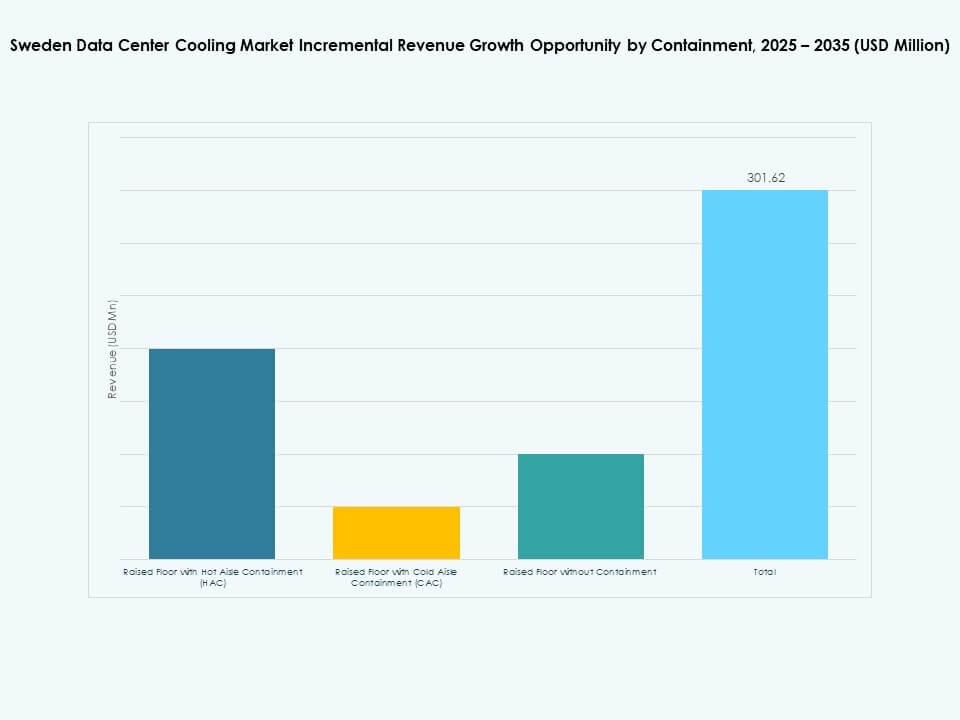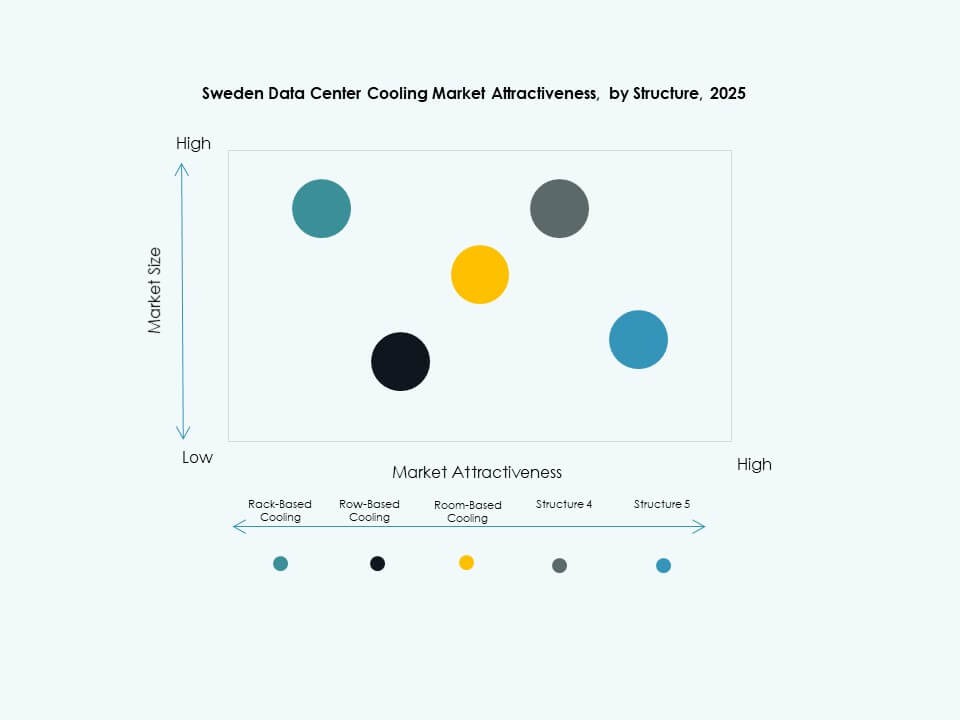1. Introduction
1.1. Market Definition & Scope
1.2. Research Methodology
1.2.1. Primary Research
1.2.2. Secondary Research
1.2.3. Data Validation & Assumptions
1.3. Market Segmentation Framework
2. Executive Summary
2.1. Market Snapshot
2.2. Key Findings
2.3. Analyst Recommendations
2.4. Market Outlook (2025–2035)
3. Market Dynamics
3.1. Market Drivers
3.2. Market Restraints
3.3. Market Opportunities
3.4. Challenges & Risks
3.5. Value Chain Analysis
3.6. Porter’s Five Forces Analysis
4. Sweden Data Center Cooling Market – Market Sizing & Forecast
4.1. Historical Market Size (2020–2025)
4.2. Forecast Market Size (2026–2035)
4.3. Market Growth Rate Analysis
4.4. Market Outlook by Country
5. Capital Expenditure (CapEx) Analysis
5.1. CapEx Trends by Cooling Solution
5.1.1. Investment patterns across air-based, liquid-based, hybrid, and immersion cooling
5.1.2. CapEx share by cooling equipment type (CRAC/CRAH, chillers, cooling towers, economizers, etc.)
5.1.3. Country-wise CapEx trends
5.1.4. OEM vs. retrofit investment analysis
5.2. Return on Investment (ROI) & Payback Period Analysis
5.2.1. ROI by cooling technology type
5.2.2. Cost-benefit comparison: air cooling vs. liquid cooling vs. immersion cooling
5.2.3. Payback period across Tier I–IV data centers
5.2.4. Case examples of cost savings through energy-efficient cooling adoption
6. Data Center Cooling Capacity & Utilization
6.1. Installed Capacity (MW & Sq. Ft.) by Cooling Solution
6.1.1. Installed cooling capacity by solution type and Country
6.1.2. Cooling system density (kW/rack and per sq. ft.)
6.1.3. Capacity expansion trends by hyperscale vs. colocation vs. enterprise
6.2. Utilization Rates & Efficiency Metrics
6.2.1. Cooling system utilization vs. design capacity
6.2.2. Average and peak load management practices
6.2.3. Equipment lifecycle and performance benchmarks
6.3. Power Usage Effectiveness (PUE) & Energy Efficiency
6.3.1. Average PUE by data center size and cooling technology
6.3.2. Comparison of traditional vs. green cooling systems
6.3.3. Cooling system contribution to total facility energy consumption
6.4. Rack Density & Cooling Efficiency
6.4.1. Average rack density (kW/rack) trends
6.4.2. Cooling adequacy vs. rack load
6.4.3. Relationship between high-density workloads (AI, HPC) and cooling requirements
7. Data Center Cooling Market, Energy & Resource Consumption Analysis
7.1. Energy Consumption Analysis
7.1.1. Total energy consumption by cooling solution type (air-based, liquid, hybrid, immersion)
7.1.2. Energy intensity per MW of IT load
7.1.3. Energy share of cooling in total facility power (cooling load ratio)
7.1.4. Annualized Energy Efficiency Ratio (EER / SEER) by cooling system type
7.1.5. Trend in energy consumption reduction through automation, AI, and free cooling technologies
7.2. Water Consumption Analysis
7.2.1. Water Usage Effectiveness (WUE) – liters per kWh of IT load
7.2.2. Water consumption by cooling technology (evaporative cooling, adiabatic cooling, etc.)
7.2.3. Water recycling and reuse systems in data centers
7.2.4. Impact of Country-wise water scarcity regulations on cooling system choice
7.2.5. Shift from water-intensive to air-based or hybrid systems
7.3. Combined Energy–Water Efficiency Metrics
7.3.1. Energy-Water Nexus in cooling optimization
7.3.2. Correlation between PUE, WUE, and total operational cost (OpEx)
7.3.3. Case studies of zero-water or waterless cooling deployments
7.4. Benchmarking & Comparative Analysis
7.4.1. Benchmarking against ASHRAE, Uptime Institute, and DOE standards
7.4.2. Comparison of Sweden WUE/PUE averages by Country
7.4.3. Best practices adopted by hyperscalers (AWS, Google, Microsoft, Meta, etc.)
8. Sweden Data Center Cooling Market – By Component
8.1. Solution
8.2. Services
9. Sweden Data Center Cooling Market – By Data Center Cooling Solution
9.1. Air Conditioners
9.2. Precision Air Conditioners
9.3. Chillers
9.4. Air Handling Units
9.5. Liquid Cooling
9.6. Others
10. Sweden Data Center Cooling Market – By Service
10.1. Installation & Deployment
10.2. Support & Consulting
10.3. Maintenance Services
11. Sweden Data Center Cooling Market – By Enterprise Size
11.1. Large Enterprises
11.2. Small & Medium Enterprises (SMEs)
12. Sweden Data Center Cooling Market – By Floor Type
12.1. Raised Floors
12.2. Non-Raised Floors
13. Sweden Data Center Cooling Market – By Containment
13.1. Raised Floor with Hot Aisle Containment (HAC)
13.2. Raised Floor with Cold Aisle Containment (CAC)
13.3. Raised Floor without Containment
14. Sweden Data Center Cooling Market – By Structure
14.1. Rack-Based Cooling
14.2. Row-Based Cooling
14.3. Room-Based Cooling
15. Sweden Data Center Cooling Market – By Application
15.1. Hyperscale Data Center
15.2. Colocation Data Center
15.3. Enterprise Data Center
15.4. Edge Data Center
15.5. Other Data Centers
16. Sweden Data Center Cooling Market – By End-user
16.1. Telecom
16.2. IT
16.3. Retail
16.4. Healthcare
16.5. BFSI
16.6. Energy
16.7. Others
17. Sustainability & Green Data Center Cooling
17.1. Energy Efficiency Initiatives
17.1.1. Deployment of free cooling, adiabatic cooling, and economizers
17.1.2. Smart control systems for temperature and airflow optimization
17.1.3. Case studies of efficiency improvement programs
17.2. Renewable Energy Integration
17.2.1. Integration of solar, wind, or geothermal sources in cooling operations
17.2.2. Hybrid systems combining renewable energy with mechanical cooling
17.3. Carbon Footprint & Emission Analysis
17.4. GHG reduction initiatives
17.5. LEED & Green Certifications
17.5.1. Share of cooling systems installed in LEED, BREEAM, or Energy Star certified facilities
17.5.2. Compliance with ASHRAE and ISO energy efficiency standards
18. Emerging Technologies & Innovations
18.1.1. Emerging Technologies & Innovations
18.1.2. Liquid Cooling & Immersion Cooling
18.1.3. Adoption rate and technology maturity
18.1.4. Key vendors and installations by Country
18.1.5. Comparative analysis: performance, cost, and energy savings
18.2. AI & HPC Infrastructure Integration
18.2.1. Cooling demand driven by AI training clusters and HPC systems
18.2.2. Adaptation of cooling design to high heat density workloads
18.3. Quantum Computing Readiness
18.3.1. Cooling requirements for quantum processors
18.3.2. Potential cooling technologies suitable for quantum environments
18.4. Modular & Edge Data Center Cooling
18.4.1. Cooling strategies for prefabricated and modular facilities
18.4.2. Compact and adaptive cooling for edge sites
18.5. Automation, Orchestration & AIOps
18.5.1. Integration of AI-driven thermal management
18.5.2. Predictive maintenance and automated cooling optimization
19. Competitive Landscape
19.1. Market Share Analysis
19.2. Key Player Strategies
19.3. Mergers, Acquisitions & Partnerships
19.4. Product & Service Launches
20. Company Profiles
20.1. Schneider Electric
20.2. Vertiv Group Corp.
20.3. Danfoss
20.4. Carrier
20.5. Mitsubishi Electric Corporation
20.6. STULZ GmbH
20.7. Rittal GmbH & Co. KG
 Market Trends
Market Trends
 Regional Insights
Regional Insights